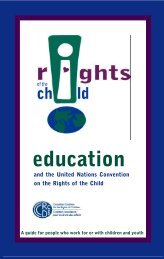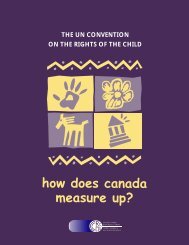CCRC report on rights of children in Canada - Canadian Coalition ...
CCRC report on rights of children in Canada - Canadian Coalition ...
CCRC report on rights of children in Canada - Canadian Coalition ...
Create successful ePaper yourself
Turn your PDF publications into a flip-book with our unique Google optimized e-Paper software.
“I’m talk<strong>in</strong>g about wheelchair access. It’s really good <strong>in</strong> my school. I th<strong>in</strong>k <strong>in</strong> my school we’re just start<strong>in</strong>g<br />
to identify this and we started a group called Stop the Stigma. We’re develop<strong>in</strong>g more respect and<br />
understand<strong>in</strong>g for physical disabilities but d<strong>on</strong>’t have much for mental disabilities.”<br />
<str<strong>on</strong>g>CCRC</str<strong>on</strong>g> Youth C<strong>on</strong>sultati<strong>on</strong>, August 24th, 2011<br />
• Children with disabilities are over-represented <strong>in</strong> prov<strong>in</strong>cial/territorial child welfare systems.<br />
• Children with disabilities are more than twice as vulnerable to violence and abuse as other <strong>children</strong>.<br />
• Almost 55% <strong>of</strong> <strong>children</strong> with disabilities who need aids and devices do not have access to them.<br />
Cost is cited as the most comm<strong>on</strong> reas<strong>on</strong>.<br />
• 40% <strong>of</strong> <strong>children</strong> with disabilities experience daily difficulties <strong>in</strong> everyday life.<br />
• Of the many parents who <str<strong>on</strong>g>report</str<strong>on</strong>g> need<strong>in</strong>g additi<strong>on</strong>al help, nearly three-quarters (73.5%) cite cost as<br />
the reas<strong>on</strong> they cannot get it.<br />
• More than <strong>on</strong>e-third <strong>of</strong> parents <str<strong>on</strong>g>report</str<strong>on</strong>g> hav<strong>in</strong>g out-<strong>of</strong>-pocket costs for gett<strong>in</strong>g the assistance they<br />
need.<br />
• 21.5% <strong>of</strong> families <str<strong>on</strong>g>report</str<strong>on</strong>g> that child care services or programs had refused to provide care for their<br />
child.<br />
• Due to their child’s disability, parents <str<strong>on</strong>g>report</str<strong>on</strong>g>:<br />
o Hav<strong>in</strong>g to work fewer hours (38.4%) or change their work hours (36.5%)<br />
o Hav<strong>in</strong>g not taken a job (26.4%)<br />
o Hav<strong>in</strong>g to quit work (21.6%)<br />
o Turn<strong>in</strong>g down a promoti<strong>on</strong> (19.7%).<br />
• Mothers are most comm<strong>on</strong>ly the ma<strong>in</strong> pers<strong>on</strong> to be impacted (64.1%).<br />
UN C<strong>on</strong>venti<strong>on</strong> <strong>on</strong> the Rights <strong>of</strong> Pers<strong>on</strong>s with Disabilities<br />
“My school had no <strong>in</strong>teracti<strong>on</strong> between abled<br />
and disabled students and I was yearbook<br />
editor and was told to take pictures <strong>of</strong> them<br />
out <strong>of</strong> the yearbook because a lot <strong>of</strong> them were<br />
<strong>in</strong> foster care. I felt like we were eras<strong>in</strong>g them<br />
from the community and I fought it and we<br />
managed to get some photos <strong>in</strong> the yearbook<br />
when they had permissi<strong>on</strong> from their parents<br />
and we got a page for Best Buddies. There’s a<br />
huge divide. They’re kept very isolated.”<br />
<str<strong>on</strong>g>CCRC</str<strong>on</strong>g> Youth C<strong>on</strong>sultati<strong>on</strong>, August 24th, 2011<br />
In December 2006, the UN General Assembly<br />
adopted the UN C<strong>on</strong>venti<strong>on</strong> <strong>on</strong> the Rights <strong>of</strong><br />
Pers<strong>on</strong>s with Disabilities (CRPD). <strong>Canada</strong> ratified<br />
the CRPD <strong>in</strong> March 2010. The CRPD is the<br />
first legally b<strong>in</strong>d<strong>in</strong>g <strong>in</strong>ternati<strong>on</strong>al treaty relat<strong>in</strong>g<br />
to disability. It marks an <strong>of</strong>ficial shift toward<br />
see<strong>in</strong>g disability as a human <strong>rights</strong> issue and<br />
firmly positi<strong>on</strong>s disability with<strong>in</strong> a progressive<br />
social model. The CRPD provides a deeper<br />
understand<strong>in</strong>g <strong>of</strong> disability and what is required<br />
to ensure that the <strong>rights</strong> <strong>of</strong> <strong>children</strong> with<br />
disabilities are realized <strong>in</strong> progressive ways.<br />
“A lot <strong>of</strong> people d<strong>on</strong>’t understand. Teachers d<strong>on</strong>’t understand. For <strong>in</strong>stance, my brother has dyslexia and<br />
his teacher doesn’t understand what it is.”<br />
<str<strong>on</strong>g>CCRC</str<strong>on</strong>g> Youth C<strong>on</strong>sultati<strong>on</strong>, October 2, 2011<br />
“My cous<strong>in</strong> goes to a school for disabled students and he has everyth<strong>in</strong>g, a counselor, bus that picks him<br />
up, food served to him. His school is really good but it’s <strong>on</strong>ly for disabled students. My cous<strong>in</strong> has various<br />
mental disorders and grow<strong>in</strong>g up he was locked <strong>in</strong>side his house. His parents were ashamed and thought<br />
he was just a weird kid. Even now, he w<strong>on</strong>’t talk to people about how he feels. I th<strong>in</strong>k he would be so<br />
much better if parents had treated him well. I used to tutor him when he was little and try and get him to<br />
talk to me. Family members have a huge impact <strong>on</strong> these <strong>children</strong> and they need to be educated.”<br />
<str<strong>on</strong>g>CCRC</str<strong>on</strong>g> Youth C<strong>on</strong>sultati<strong>on</strong>, August 24th, 2011<br />
Violence and Abuse and the Right to Life,<br />
Survival and Development<br />
Children with disabilities are disproporti<strong>on</strong>ately represented am<strong>on</strong>g victims <strong>of</strong> child maltreatment.<br />
Estimates suggest that <strong>children</strong> with disabilities are two or more times more likely to be victims <strong>of</strong><br />
child abuse than <strong>children</strong> without disabilities. Despite an overall drop <strong>in</strong> homicide rates am<strong>on</strong>g the<br />
general populati<strong>on</strong>, there appears to be an <strong>in</strong>crease <strong>in</strong> homicide and filicide rates aga<strong>in</strong>st people<br />
with disabilities. Additi<strong>on</strong>ally, there are questi<strong>on</strong>s about systemic discrim<strong>in</strong>ati<strong>on</strong> aga<strong>in</strong>st <strong>children</strong> with<br />
disabilities <strong>in</strong> relati<strong>on</strong> to access<strong>in</strong>g an equal standard <strong>of</strong> health care, especially for those with significant<br />
support needs. Quality <strong>of</strong> life arguments are <strong>of</strong>ten found at the heart <strong>of</strong> complex ethical issues related<br />
to health care for people with disabilities. Such assessments are subjective and vulnerable to negative<br />
assumpti<strong>on</strong>s and beliefs about life with disability.<br />
Inclusive Lifel<strong>on</strong>g Learn<strong>in</strong>g<br />
Lifel<strong>on</strong>g patterns <strong>of</strong> <strong>in</strong>clusi<strong>on</strong> are established <strong>in</strong> early childhood educati<strong>on</strong> programs, preschools,<br />
classrooms, and <strong>on</strong> neighbourhood playgrounds. Research reveals that <strong>children</strong> with disabilities who<br />
are <strong>in</strong>cluded <strong>in</strong> their early years have better outcomes for <strong>in</strong>clusi<strong>on</strong> as adults. When <strong>children</strong> and youth<br />
with disabilities grow and learn al<strong>on</strong>gside their peers, they are more likely to c<strong>on</strong>t<strong>in</strong>ue <strong>in</strong> educati<strong>on</strong>,<br />
get jobs, have <strong>in</strong>comes above the poverty l<strong>in</strong>e, and be <strong>in</strong>cluded and valued <strong>in</strong> their communities. There<br />
are still <strong>in</strong>cidents, however, where schools and school boards <strong>in</strong>appropriately separate <strong>children</strong> with<br />
disabilities or fail to provide appropriate support.<br />
Supports to Families<br />
The C<strong>on</strong>venti<strong>on</strong> recognizes that <strong>children</strong> should be supported to live at home with their families and<br />
that families are entitled to the supports they require to raise their <strong>children</strong> at home. <strong>Canada</strong> is do<strong>in</strong>g<br />
a great deal to support families <strong>in</strong> this regard, but more is needed. In additi<strong>on</strong> to improved disabilityspecific<br />
supports and services for families, <strong>on</strong>e <strong>of</strong> the best supports for families is to ensure that the<br />
<strong>rights</strong> <strong>of</strong> <strong>children</strong> are realized <strong>in</strong> <strong>in</strong>clusive ways. Access to services – health care, educati<strong>on</strong>, sports and<br />
recreati<strong>on</strong> – provides significant support for families who have a child with a disability to live typical<br />
lives.<br />
76 Right <strong>in</strong> pr<strong>in</strong>ciple, right <strong>in</strong> practice Pay<strong>in</strong>g Attenti<strong>on</strong> to Vulnerable Children 77




